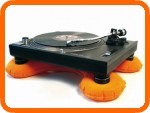 |
 |  |  |  |  |  |  |
freefloat //
from stone to airpillow |
 |
 |
the stone age
Dance music changed track in the early Nineties. The first new-style dance parties were organized on a small scale, with a tantalizing suggestion of illegality. Musicians and self-styled DJs got into the groove by mixing music and music styles of their own creation. And their audiences grooved along with them. Experimenting DJs switched from mellow to techno and hardcore.
The crowds kept coming. They wanted to dance. Bigger parties needed bigger sound systems to satisfy the demand of the crowd, who wanted the music to be LOUDER and the beat to be MORE INTENSE. The most sensitive point in traditional turntables, the stylus, gradually caused a very serious problem: it started skipping more and more as a result of the shocks and vibrations around it. And as if that wasn't bad enough, the sound reverberated excessively, impairing its clarity. RUMBLE, a horror to every music lover, started to occur.
Skipping and rumble
In the mid-Nineties DJs and party organizers around the globe were fighting sound contamination caused by skipping and rumble. Rumble occurs when vibrations caused by bass tones hit your deck and your needle. The element then starts vibrating at the same frequency. A loop between the speakers and the element makes the air vibrate, producing the sound we have come to know as rumble.
The problem had to be tackled professionally. The initial idea was to absorb shocks by ADDING WEIGHT. Here and there extra piles were driven into the ground below discotheques to create more stability. The foundations of the DJ's domain were strengthened. Unfortunately, it hardly made any difference.
At the end of the 1990s, Matrix, a sound rental company in Breda designed the Freefly. This was a big metal frame on a pile of pavement tiles, hung in four rubbers as used in the car industry. Its total weight was about 15 kilos.
Wow! The results were impressive. From now on, DJs and organizers of larger dance events were keen to get their hands on the Freefly. End of story? Certainly not! The Freefly worked well, but only for want of something better. Besides, it was only available in the Netherlands, while DJs all over the world were yearning for a solution for skipping and rumble.
|
 |
 |
airborne!
The Freefloat: no trumped-up story
Summer 2003. The inventors of the Freefly introduce a playful and yet very serious new product: the Freefloat. After years of experiments, improvements and refinements the solution for skipping and rumble comes from an unexpected source: shock absorption through the ingenious use of AIR.
What exactly is the Freefloat?
The Freefloat looks like a cheerful inflatable cushion for use on the beach, in the bath or in the car. Which it is NOT. Place the Freefloat under your turntable and discover that it can solve your problem: the Freefloat is a combined shock absorption and stabilizer system.
The absorption is caused by the elasticity and rolling effect of the air balls on the four corners. Linking those four balls via diagonal air tubes with a fifth ball in the centre causes the stabilization. Through the correct combination of flexibility (hardness of the balls), stability (hardness of the tubes) and positioning of the balls in relation to your turntable the Freefloat achieves optimum absorption of environmental shocks.
The Freefloat's calculated use of air and elasticity stifles shocks and vibrations. You'll find that the Freefloat has more than one setting to help you control the way your booth moves and the way the sound system influences your sound, depending on the booth's location.
What's the result?
By using the Freefloat the turntable's tendency to skip is reduced by a factor 10 to 20. In addition, you can play at a higher volume than previously while retaining the complete frequency range before the first rumble occurs (around 20 to 30 dBu!)
Which means...
The manufacturers have decided to market the Freefloat at a very reasonable price. A Freefloatô for every DJ - that's the idea. For the Freefloat is extremely user friendly. And the Freefloat provides maximum sound perception for every DJ and raver. Everyone can now echo Tiësto, heaving a sigh of relief: "Freefloat SAVED my party"
However
The Freefloat is ONLY for PROFESSIONALS. Do not expect your Freefloat to work miracles in a lousy working environment. A good DJ DEMANDS from the organization that his place of work is OK. Of course your Freefloat cannot compensate for a very wobbly base. The Freefloatô must also be entirely freestanding. The shock absorption suffers, for example, if badly concealed wires rub up against your Freefloat.
Ask for a sufficient supply of reserve styluses and an ashtray for your fag! Then, it's time to play. You'll hear the difference INSTANTLY: the bass frequencies are tighter and you don't need to make as many electronic adjustments. The sound is more dynamic, and the audience experiences this better sound. Feel free to groove along with them - dancing and jumping behind your turntable causes no problem.
|
|
 |
 |
 |
|